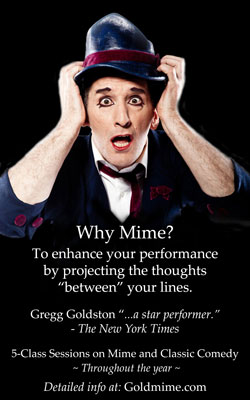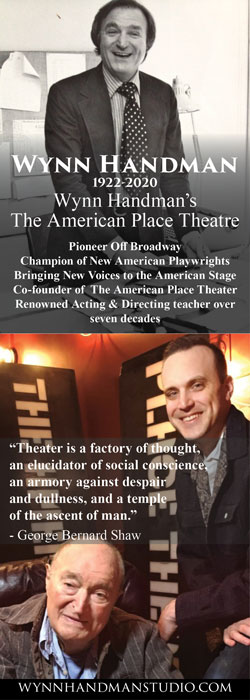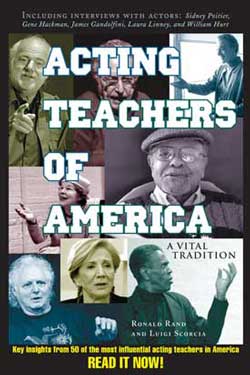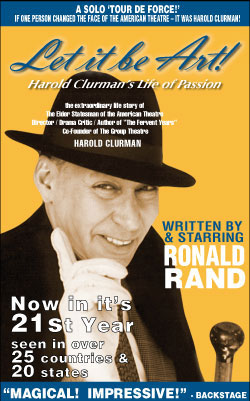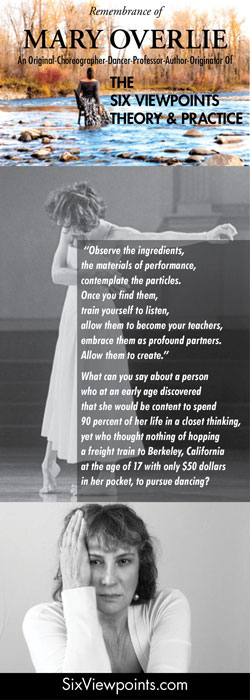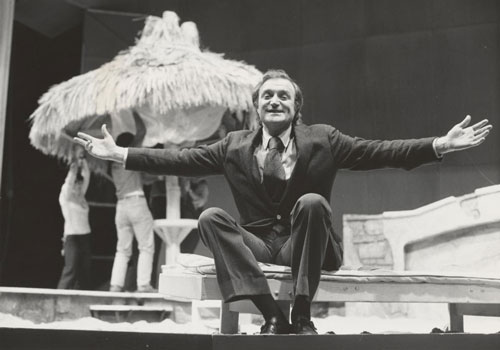
Wynn Handman on stage at American Place Theatre
Let These New Plays Happen to You
February, 1977
Contemporary “experimental” plays have created a controversy in the pages of “The New York Times” in recent weeks.
A letter –“Defending The American Place Theatre,” on February 20th – written by Howard Klein, Director of Arts at the Rockefeller Foundation, appeared in response to Walter Kerr’s sharply negative criticism of the institution for our recent choices of plays, provoked by his dislike for our latest offering, “Isadora Duncan Sleeps with the Russian Navy’ – in his review, “How to Pass Time When You Can’t Stand the Play,” on February 9th.
Over the years The American Place has given room to contemporary plays and their authors. As Director of the Theatre, I am prompted to share my thoughts on the difficulties currently experienced by playwrights, critics and audiences.
There is a litany derived from hundreds of post-play discussions at The American Place and countless reviews of new writing by American playwrights. It goes like this: “I can’t identify with the characters,” “I can’t follow the story,” “I wasn’t moved,” “I don’t know the author’s point of view,” “There’s no resolution,” “What’s the theme?.” To “What does it all mean?”
These are responses to plays by writers whose works reflect a chaotic world, its fragmentation, ambiguity, terror, and random, rapid, directionless change.
Writers who apply a modern consciousness to reality write in ways that may seem disoriented, unresolved, and mystifying. They will not write in what they feel to be a false tempo or surge. They will not pretend that they feel cause-and-effect is a natural modern progression. They will not shape facts and events into resolutions.
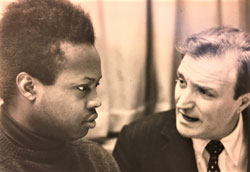 |
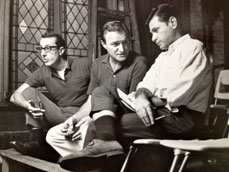 |
| Wynn Handman ‘s encouragement of young playwrights was never-ending. On the right: Playwrights Frank Gagliano and Ronald Ribman with Wynn Handman |
|
No one producing plays or writing them wants to disappoint the audience or the critics; the achievement lies in the communication, in the shared discovery, in the revelation of mankind to itself.
I once heard Lukas Foss say that as much as he loves to listen to and perform Mozart and Beethoven, as a contemporary composer he has to write as a person of his time. While in music, dance, architecture and painting the struggle for modernism has been waged and won, in the theatre, the battle is only beginning.
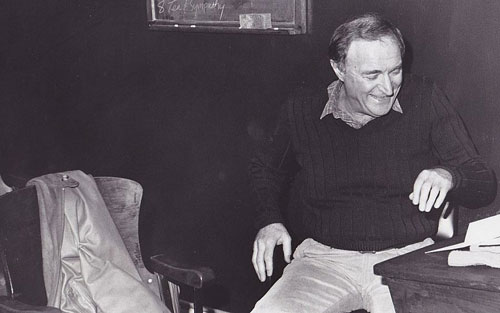
Wynn Handman
It started in our time with the seminal work for today’s playwright, “Waiting for Godot,” written by Samuel Beckett and produced in the United States in 1956. Its plotless, seemingly nonsequential events, its lean language turning on itself, its unconnected arias, its unpretentious arguments about life, religion, purpose, existence, suffering, produced in the public and press (with some exceptions) violent reactions and self-righteous sophistry.
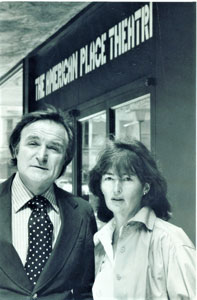
Wynn Handman with Julia Miles, Founder of The Women’s Project in New York City
But those who were available to the work, without turning apoplectic found that art once again had made the world much clearer; that as Alfred North Whitehead reported to us, “Our reasonings grasp at straws for premises and float on gossamers and deductions.”
Also coming from abroad, the plays of Arrabal and Pinter astonished and alarmed their critics and audiences. Arrabal’s avant-garde classic, circa 1965, “The Architect and the Emperor of Assyria” received a reprieve recently in a wonderful rendering at La Mama and was acclaimed by Clive Barnes, who asked for understanding for missing its merits in 1971.
“Presumably, even critics develop,” Mr. Barnes wrote. “When I first saw Fernando Arrabel’s play, “The Architect and the Emperor of Assyria,” at Britain’s National Theatre in 1971, I was honestly somewhat unimpressed. I did not really understand it – perhaps because all critics are slightly behind their times…on Friday night at La Mama annex….I was overwhelmed. It was a great theatrical experience.”
To the Editor:
Harold Pinter’s plays come to America with a better welcome because of the stars attracted to the roles, like the marvelous Sirs – John Gielgud and Ralph Richardson. In a recent article about “No Man’s Land” in The Times, they conversed about the audience’s difficulty with plays like Pinter’s and reminded each other that Ibsen, Chekhov, and Strindberg were initiated into the theater with the same kind of belligerence.
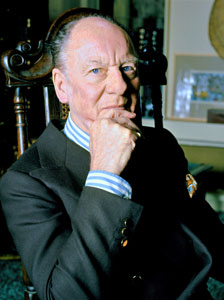
Sir John Gielgud (photo: Allen Warren)
“’I think we do lose people in the audience,” said Sir John. “I think the play needs a lot of concentration, and a certain attitude of mind. You’ve got to accept the suspense and the surprises and not worry too much about what it all sums up to. You must never expect it to be a play with a real story and a climax and all that.” Sir Ralph Richardson nodded in vigorous agreement. “The whole thing is,” he said, “these plays should not be taken too seriously, too literally. It’s a kind of shorthand, like a painting by Ben Nicholson….You see? A stroke here, another there; suggestions of meaning. You have to use your imagination.”
We now take a leap in time and place but within the same universe to Sam Shepard who by the age of twenty-two had become our literary Yankee Doodle, our Jesse James of letters, our “Cowboy Mouth.” He speaks of and for the America he knows so well, that of a generation which pushed itself out of bourgeois aggression and failure, which ran itself ragged on drugs and tripping, which braced itself for a life of inaction, terror and disappointment. Shepard’s plays are always about something; and the idea, the something, always impels the characters and their situations, but not in a conventional form.
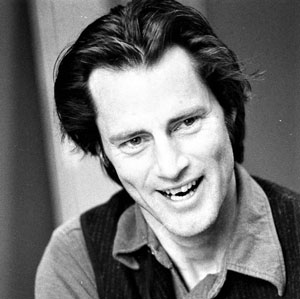
Sam Shepard
Shepard’s plays are collages, jazz improvisations with abrupt changes and shifts. “La Turista,” his first full-length play, is about disappearing – peeling away or disappearing from sunburn; or burning up, draining away or disappearing from dysentery; sleeping away or disappearing from drugs or sleeping sickness; disappearing into death, death with nothing left but the traces, the outlines. Everything in this play germinates from the central idea and erupts like geyser water from the source, bits and pieces of a fractured whole.
When “La Turista” was first presented at The American Place Theatre in 1967, Shepard decided against inviting the critics. He didn’t want anyone connected with the creation of the production to feel the pressure of success or failure based on the critics’ opinions. He watched the audience every night. By the end of the play, half the audience was riveted, transfixed, watching the actors in the last gasps of despair and exhaustion.
The other half of the audience had left in the course of two acts, some of them still thrashing about at the back of the theatre, railing at the author and producer. Now, in 1977, the general press, the public and resident regional theatres are more receptive to a new play by Sam Shepard. This is one indication that innovative American playwrights may be finding a greater acceptance.
Also, among the reviews of John Guare’s latest work, “Marco Polo Sings a Solo,” there was evidence that more critics are using non-traditional criteria when evaluating a non-traditional play. Richard Eder in “The New York Times” wrote, “Points are out of fashion. On the stage, nowadays, the point of a play is rarely the point. It is the style and complications that count; the mess more than the message. It is the sensation of flight, the small updrafts, that provide the excitement; not the destination, which tends to amount to a great circle and back to the place we took off from.”
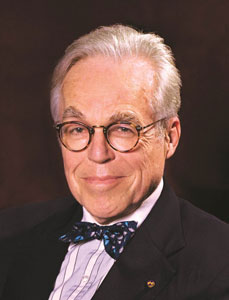
John Guare
Some of the critics considered the body of Guare’s work in their appraisal, separated out their negative and positive response, and avoided the temptation to condemn the writer to that place from which he or she finds it difficult to return.
But we wonder who among the talented writers in the contemporary idiom will share the territory of asylum won by Shepard and Guare. Jack Gelber? Adrienne Kennedy? David Mamet? Rochelle Owens? Ronald Tavel? William Hauptman?

William Hauptman
Take the case of Hauptman for example. His play “Domino Courts,” recently produced by The American Place, is inhabited by characters who are not meant to be portrayals of ‘real’ people. They are archetypes from the mythological world of gangster movies of the 1930’s living in the Oklahoma dustbowl.
Their world is made of dust, pasteboard and celluloid; their dreams are pathetically shallow. Images of the arid landscape of the dustbowl, of the slapstick and melodrama coming from their diet of films, and occasional moments of surreal nightmares fill the stage. It’s not a play in the conventional sense, but a textured poetic event – a depiction of an American wasteland.
As richly evocative as the play was for many of those who saw it, it offered nothing to many others. The latter found it boring, devoid of plot and reality, silly, without identifiable characters – a total failure. And then there were those who understood the world of the play but were critical of it within its own purview. Their responses did not suffer from an unyielding adherence to traditional viewpoint; therefore, their expectations were not defeated by the play.
Elizabeth Hardwick, in her preface to Shepard’s “La Turista” analyzes the reasons for the audience’s problems with new forms and new contexts: “George Eliot said that she wrote her novels out of the belief in ‘the orderly sequence by which the seed brings forth a crop of its kind.’ We all have a nostalgia and longing for this order because it has been the heart of European fiction and drama. Incident after incident, each growing out of the other, united in a chain of significant motivation, of cause and effect…”
“Yet each decade brings us the conviction that this order is no longer present to the serious writer. It Is most appealing to those writers who construct their works for some possibility of the marketplace. The episodic, the obscurely related, the collections of images, moods; connections in fiction and also in drama have become like those of poetry. Tone and style hold the work together, create whatever emotional effect it will have on us.”
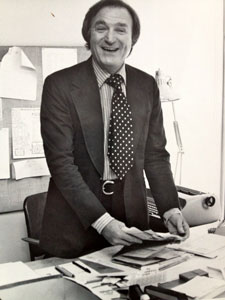
Wynn Handman
I have suggested to the puzzled in the audiences at post-play discussions that they let themselves be available to the new worlds of these plays – do not work at finding meanings, let it happen to you, let the spray play on you, let the images soak in, let yourself move into a new space. Have room for contemporary writers. www.wynnhandmanstudio.com. 1977 Reprinted with the permission of Billy Lyons.
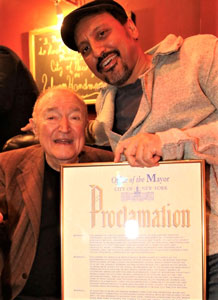
Wynn Handman with Declaration by Mayor of the City of New York: “I , Mayor Bill de Blasio do hereby proclaim Wednesday March 1st in the City of New York – Wynn Handman Day!”
Below Wynn Handman with Billy Lyons
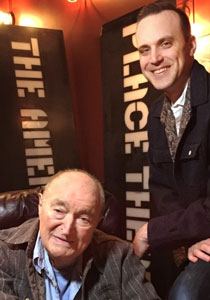 Wynn Handman (1922-2020) was the Artistic Director of The American Place Theatre, which he co-founded with Sidney Lanier and Michael Tolan in 1963. The first full production at the American Place Theatre was “The Old Glory,” a trilogy of three one-acts by the poet Robert Lowell, produced in November 1964. The play would go on to win five Obie Awards, including "Best American Play. Mr. Handman initiated several Arts Education Programs, including ‘Literature to Life.’ The plays he directed at The American Place Theatre include: “Manchild in the Promised Land,” which he adapted from the novel by Claude Brown; “I Stand Before You Naked” by Joyce Carol Oates; “Words, No Music” by Calvin Trillin; “Drinking in America” by Eric Bogosian; “A Girl’s Guide to Chaos” by Cynthia Heimel; “Free Speech in America,” and “Bibliomania” by Roger Rosenblatt with Ron Silver; “Coming Through” also adapted by Handman; “Spokesman” written and performed by John Hockenberry; “Fly” by Joseph Edward; and “Dreaming in Cuban” and “Other Works: “Rhythm,” “Rum,” “Café con Leche” and “Nuestros Abuelos” by Cristina García and Michael Garcés. Significant playwrights have been nurtured and, in many cases, initially produced at The American Place, such including eight plays by Sam Shepard including one co-authored with Joseph Chaiken; six plays by Ronald Ribman; six plays by Steve Tesich; four plays by María Irene Fornés, including one produced as part of The Women’s Project; five plays by Ed Bullins; three plays by Phillip Hayes Dean; three plays by William Hauptman; Frank Chin, the first Asian American to have plays produced by a mainstream New York company – “The Chickencoop Chinaman” and “The Year of the Dragon”); four plays by Jonathan Reynolds; William Alfred; Michael Bradford; Kia Corthron, Joseph Edward; Lonne Elder III; Bill Irwin; Elaine Jackson; James de Jongh; Alonzo D. Lamont Jr.; Aasif Mandvi; Emily Mann; Dael Orlandersmith; Richard Nelson; Ron Milner; Matt Robinson; Charlie L. Russell; and Vincent Smith. The American Place Theatre Humorists' Series transferred from the page-to-live performance the work of outstanding humorous writers, among them George Ade, Robert Benchley, Roy Blount Jr., A. Whitney Brown, Jules Feiffer, Bruce Jay Friedman, Cynthia Heimel, Dorothy Parker, Roger Rosenblatt, Damon Runyon, Jean Shepherd, James Thurber, and Calvin Trillin. In 1978, The Women’s Project, founded by Julia Miles, for nine years produced many groundbreaking works at The American Place Theatre encouraging, developing, and producing women playwrights and directors. A renowned acting teacher for over fifty years, Mr. Handman trained many outstanding actors including Mary Alice, Alec Baldwin, Ellen Barkin, Roscoe Lee Brown, Heather Burns, Kathleen Chalfant, Chris Cooper, Michael Douglas, Olympia Dukakis, Sandy Duncan, Michael Douglas, Faye Dunaway, Morgan Freeman, Richard Gere, Lauren Graham, Frank Langella, Mia Farrow, Allison Janney, Raul Julia, John Leguizamo, Susan Lucci, Zakes Mokae, Howard Rollins, Anna Deavere Smith, Mira Sorvino, John Spencer, Marilise Tronto, Denzel Washington and Sigourney Weaver. Mr. Handman was a recipient of the 1999 Obie for Sustained Achievement; the Lucille Lortel Award for Lifetime Achievement presented by the League of Off-Broadway Theatres; AEA Rosetta LeNoire Award; two Audelco Black Theatre Awards, as Best Director for “Zora Neale Hurston,” and “Fly;” Carnegie Mellon Drama Commitment to Playwriting Award; Working Theatre’s Sanford Meisner Service Award; he was honored by The New Federal Theatre; the Townsend Harris Medal, and received a Doctor of Humane Letters by the University of Miami. His life and career has been documented in Jeremy Gerard's 2014 book, Wynn Place Show: A Biased History of the Rollicking Life & Extreme Times of Wynn Handman and The American Place Theatre, and in the 2019 Netflix documentary, “It Takes a Lunatic.”
Wynn Handman (1922-2020) was the Artistic Director of The American Place Theatre, which he co-founded with Sidney Lanier and Michael Tolan in 1963. The first full production at the American Place Theatre was “The Old Glory,” a trilogy of three one-acts by the poet Robert Lowell, produced in November 1964. The play would go on to win five Obie Awards, including "Best American Play. Mr. Handman initiated several Arts Education Programs, including ‘Literature to Life.’ The plays he directed at The American Place Theatre include: “Manchild in the Promised Land,” which he adapted from the novel by Claude Brown; “I Stand Before You Naked” by Joyce Carol Oates; “Words, No Music” by Calvin Trillin; “Drinking in America” by Eric Bogosian; “A Girl’s Guide to Chaos” by Cynthia Heimel; “Free Speech in America,” and “Bibliomania” by Roger Rosenblatt with Ron Silver; “Coming Through” also adapted by Handman; “Spokesman” written and performed by John Hockenberry; “Fly” by Joseph Edward; and “Dreaming in Cuban” and “Other Works: “Rhythm,” “Rum,” “Café con Leche” and “Nuestros Abuelos” by Cristina García and Michael Garcés. Significant playwrights have been nurtured and, in many cases, initially produced at The American Place, such including eight plays by Sam Shepard including one co-authored with Joseph Chaiken; six plays by Ronald Ribman; six plays by Steve Tesich; four plays by María Irene Fornés, including one produced as part of The Women’s Project; five plays by Ed Bullins; three plays by Phillip Hayes Dean; three plays by William Hauptman; Frank Chin, the first Asian American to have plays produced by a mainstream New York company – “The Chickencoop Chinaman” and “The Year of the Dragon”); four plays by Jonathan Reynolds; William Alfred; Michael Bradford; Kia Corthron, Joseph Edward; Lonne Elder III; Bill Irwin; Elaine Jackson; James de Jongh; Alonzo D. Lamont Jr.; Aasif Mandvi; Emily Mann; Dael Orlandersmith; Richard Nelson; Ron Milner; Matt Robinson; Charlie L. Russell; and Vincent Smith. The American Place Theatre Humorists' Series transferred from the page-to-live performance the work of outstanding humorous writers, among them George Ade, Robert Benchley, Roy Blount Jr., A. Whitney Brown, Jules Feiffer, Bruce Jay Friedman, Cynthia Heimel, Dorothy Parker, Roger Rosenblatt, Damon Runyon, Jean Shepherd, James Thurber, and Calvin Trillin. In 1978, The Women’s Project, founded by Julia Miles, for nine years produced many groundbreaking works at The American Place Theatre encouraging, developing, and producing women playwrights and directors. A renowned acting teacher for over fifty years, Mr. Handman trained many outstanding actors including Mary Alice, Alec Baldwin, Ellen Barkin, Roscoe Lee Brown, Heather Burns, Kathleen Chalfant, Chris Cooper, Michael Douglas, Olympia Dukakis, Sandy Duncan, Michael Douglas, Faye Dunaway, Morgan Freeman, Richard Gere, Lauren Graham, Frank Langella, Mia Farrow, Allison Janney, Raul Julia, John Leguizamo, Susan Lucci, Zakes Mokae, Howard Rollins, Anna Deavere Smith, Mira Sorvino, John Spencer, Marilise Tronto, Denzel Washington and Sigourney Weaver. Mr. Handman was a recipient of the 1999 Obie for Sustained Achievement; the Lucille Lortel Award for Lifetime Achievement presented by the League of Off-Broadway Theatres; AEA Rosetta LeNoire Award; two Audelco Black Theatre Awards, as Best Director for “Zora Neale Hurston,” and “Fly;” Carnegie Mellon Drama Commitment to Playwriting Award; Working Theatre’s Sanford Meisner Service Award; he was honored by The New Federal Theatre; the Townsend Harris Medal, and received a Doctor of Humane Letters by the University of Miami. His life and career has been documented in Jeremy Gerard's 2014 book, Wynn Place Show: A Biased History of the Rollicking Life & Extreme Times of Wynn Handman and The American Place Theatre, and in the 2019 Netflix documentary, “It Takes a Lunatic.”

Wynn Handman. During World War II, he served in the Coast Guard as a junior officer aboard the USCG Storis, an icebreaker that escorted freighters in the North Atlantic, patrolled the east coast of Greenland, and captured the crew of a German weather station.







































